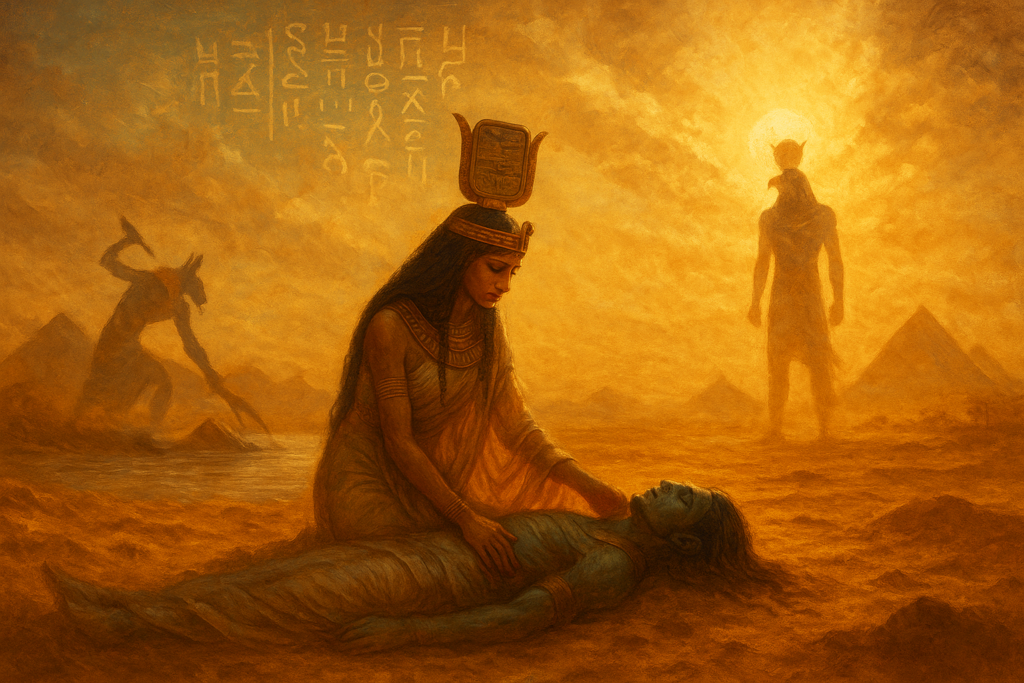In the pantheon of ancient myths that still echo through modern minds, few resonate like the Osiris Isis influence. This powerful Egyptian tale—rich in betrayal, death, devotion, and resurrection—has endured for millennia, not only as a cornerstone of mythological storytelling but as a blueprint for how justice, order, and healing can emerge from chaos.
Where other myths rage with rebellion or end in destruction—like Ragnarok’s Norse apocalypse or Prometheus’s fire of defiance—the story of Osiris and Isis centers on restoration. In a world facing widespread injustice, emotional burnout, and cultural fragmentation, their myth offers a strikingly hopeful message: justice may sleep, but it can rise again through love, persistence, and truth.
The Myth of Osiris and Isis: A Tale of Betrayal and Restoration

Long before the Greek or Norse pantheons were codified, ancient Egyptians told of a just and noble king—Osiris—who brought order and agriculture to the land. His jealous brother Set, driven by envy and rage, murdered him, dismembered his body, and scattered it across Egypt. But Osiris’s story didn’t end there.
His wife and sister, the goddess Isis, embarked on a sacred quest. Through magic, devotion, and unyielding strength, she gathered the pieces of Osiris, reassembled his body, and revived him just long enough to conceive their son, Horus. This child would grow to challenge Set and reclaim the balance of Ma’at—the divine order of truth and justice.
This myth is more than a spiritual allegory; it is a cycle of justice undone and justice restored. It doesn’t promise revenge—it enacts rebirth. Osiris becomes the lord of the underworld, not in defeat, but in eternal guardianship.
As the British Museum’s profile on Osiris notes, his transformation into ruler of the afterlife marked a pivotal shift in ancient Egyptian ideas about death, morality, and legacy.
Isis, far from a passive figure, emerges as the embodiment of fierce, sacred commitment.
Their story is the heartbeat of Egyptian spiritual life, and its echoes are more than ancient—they are present, pulsing through modern narratives of healing, restoration, and resilience.
Symbols of Rebirth: Osiris in Modern Spiritual and Cultural Thought
The Osiris Isis influence is perhaps most enduring in the way it frames death not as an end, but as a transformation. In modern spiritual and psychological contexts, Osiris is no longer just the green-skinned ruler of the dead—he is a symbol of cyclical renewal, grief transmuted into growth, and the promise of rebirth after rupture.
In contemporary paganism, Osiris is venerated as a seasonal deity, mirroring the agricultural cycle: dying in harvest, resting in the soil, and rising in spring. This mirrors how individuals navigate personal “winters”—periods of loss, depression, or disconnection—with the belief that rebirth is possible.
Psychologists and grief counselors also invoke Osiris as a mythic archetype for processing trauma. Just as Isis gathers the broken pieces of her beloved, people piece together shattered parts of themselves. In this light, Osiris becomes a guide through mourning—a spiritual metaphor for those rebuilding a sense of self after profound loss.
Cultural narratives echo this too. From literature to film, the “resurrected king” or “fallen leader restored to dignity” trope traces back to Osiris. He is the archetype of return, not in vengeance, but in purpose. He reminds us that even in decay, something sacred awaits resurrection.
And while Prometheus offers us the fire of rebellion, Osiris offers us the soil of renewal—a quieter but no less powerful mythic inheritance for those seeking meaning in moments of despair.
Isis as Archetype: Feminine Power and Devotion Across Ages
If Osiris represents justice reborn, Isis is the force that makes that rebirth possible. Across time, her mythic figure has transcended ancient borders, evolving into a symbol of divine femininity, unwavering loyalty, and transformative strength. The Osiris Isis influence on modern perceptions of womanhood, leadership, and sacred love is profound.
In ancient Egypt, Isis was revered not only as a goddess of magic and motherhood, but as a cosmic weaver—one who restored what had been torn apart. Her rituals influenced everything from healing spells to state ceremonies. But her legacy didn’t stop at the Nile.
When Egyptian myths intermingled with Greco-Roman culture, Isis became one of the most widespread deities in the ancient world, her temples standing from Alexandria to London. Today, she is embraced in neo-pagan and feminist spiritual circles as a goddess of empowerment—a figure who does not yield to loss, but reshapes it.
She also reappears in popular media. From fantasy heroines who rebuild broken realms to maternal figures who shield and guide the hero’s journey, echoes of Isis are everywhere. Her story of resilience through sacred purpose offers a powerful counterpoint to the often violent or passive roles given to women in myth.
According to the British Museum’s biography of Isis, she was venerated not only for her magical abilities but also as a protector of the pharaoh and a symbol of royal authority and compassion.
Isis is not a background figure—she is the catalyst, the seeker, the rebuilder. In today’s world, where healing, truth, and transformation are often left to grassroots movements and caregivers, the Osiris Isis influence reminds us that these roles are revolutionary.
Osiris Isis Influence on Justice and Order Today
The myth of Osiris and Isis is not just a story of love and resurrection—it is a profound meditation on justice. Unlike tales driven by revenge or wrath, the Osiris Isis influence reflects a model of justice that seeks restoration, not destruction. In this sense, the myth anticipates some of today’s most progressive ideas in social justice and ethics.
When Set kills Osiris, the response is not a bloodbath but a reordering of balance. Isis reclaims her husband’s body through compassion and sacred effort, while Horus—born of their union—challenges Set not out of vengeance, but to restore harmony to the world. It is the divine principle of Ma’at—truth, balance, and cosmic justice—that guides their actions, not personal grievance.
This vision has found echoes in restorative justice movements, where the focus shifts from punishment to healing. Rather than asking “How can we destroy the wrongdoer?” the question becomes “How can we repair what was broken?” The Osiris Isis influence offers a mythological precedent for this deeper, more human-centered vision of justice.
This vision has found echoes in restorative justice practices, which aim to repair harm through dialogue, accountability, and healing.
In legal ethics, the myth encourages a broader view of what justice can mean: not retribution, but restitution and rebirth. It suggests that the path to true resolution may lie not in dominance, but in integration, reconciliation, and the courage to confront the past with compassion.
As Ragnarok teaches us about collapse, and Prometheus reminds us of rebellion, Osiris and Isis offer a third mythic path—one that seeks to rebuild what was lost, and to do so with sacred intention.
Echoes in Popular Culture and Media
Though their statues stand in ancient ruins, Osiris and Isis are far from forgotten. The Osiris Isis influence pulses through modern stories—retold in books, reimagined in films, and revived in symbolic form across visual art and interactive media.
In literature, the themes of resurrection, sacred union, and justice restored appear in everything from epic fantasies to contemporary dramas. Characters modeled on Isis often take the form of the quiet yet powerful protector—the one who carries the broken, gathers the fallen, and helps others rise. Osiris figures, meanwhile, are the noble archetypes who fall not in shame, but in service—and are returned to relevance through grace, not violence.
Cinema, too, has absorbed their myth. Stories of love transcending death, the broken world made whole, and divine children fulfilling ancestral destinies mirror the Osiris-Horus arc. Even in modern superhero films or serialized sagas, these patterns persist: a hidden truth, a fall from grace, a return that heals rather than harms.
For a curated look at how mythologies shape our screens, explore our TV shows inspired by myths in 2025.
And perhaps most visibly, Isis’s image has re-emerged in modern art and digital spaces. She appears on tarot cards, in performance art, and in cultural festivals as a symbol of feminine wisdom and regenerative power. Her story, rooted in ancient soil, now grows across global platforms.
As more audiences seek stories with depth and meaning, mythologies like that of Osiris and Isis continue to find new forms. Just as Ragnarok has thundered into science fiction and Prometheus has ignited philosophical thrillers, the Osiris Isis narrative thrives as a blueprint for healing, justice, and love reborn.
Personal and Collective Renewal: Why the Myth Still Matters
At its heart, the Osiris Isis influence is not just myth—it’s medicine. Their story invites us to look within and ask: What have we lost? What can be restored? In times of personal grief or collective upheaval, the myth offers a sacred script for renewal.
On an individual level, Osiris represents the part of us that falls—through heartbreak, trauma, or transition. Isis is the part that refuses to give up, that gathers the fragments and begins again. Their myth reminds us that healing is not linear, but it is possible. That justice, though delayed, can arrive—reborn through effort and love.
Collectively, in a world reckoning with inequality, displacement, and ecological harm, the myth offers not escape but engagement. It calls us to become seekers like Isis, protectors like Horus, and guardians like Osiris—to rebuild systems not as they were, but as they could be.
he myth of Osiris and Isis has endured not because it is old, but because it is true in the deepest ways—true to our pain, our hope, and our desire to see justice rise from the ashes of ruin.
As we navigate personal challenges or societal breakdowns, this ancient Egyptian tale continues to offer profound insight. The Osiris Isis influence teaches us that what falls can rise, that love is an act of creation, and that justice is not a sword, but a circle.
For readers drawn to the rich symbols, sacred themes, and timeless wisdom of Egyptian lore, don’t miss our guidebook, Egyptian Mythology for Beginners—a deeper dive into the gods, legends, and spiritual lessons of the Nile.
Where do you see the myth of Osiris and Isis reflected in today’s world? We’d love to hear your thoughts in the comments below.




Hi Neat post Theres an issue together with your web site in internet explorer may test this IE still is the marketplace chief and a good component of people will pass over your fantastic writing due to this problem
Your blog is a beacon of light in the often murky waters of online content. Your thoughtful analysis and insightful commentary never fail to leave a lasting impression. Keep up the amazing work!
Thanks I have just been looking for information about this subject for a long time and yours is the best Ive discovered till now However what in regards to the bottom line Are you certain in regards to the supply
This is a great article, i am simply a fun, keep up the good work, just finish reading from https://websiteerstellenlassenbamberg.de// and their work is fantastic. i will be checking your content again if you make next update or post. Thank you